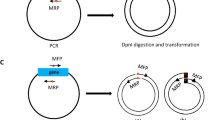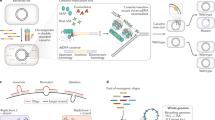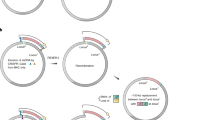Abstract
The cloning of foreign DNA in Escherichia coli episomes is a cornerstone of molecular biology. The pioneering work in the early 1970s, using DNA ligases to paste DNA into episomal vectors, is still the most widely used approach. Here we describe a different principle, using ET recombination1,2, for directed cloning and subcloning, which offers a variety of advantages. Most prominently, a chosen DNA region can be cloned from a complex mixture without prior isolation. Hence cloning by ET recombination resembles PCR in that both involve the amplification of a DNA region between two chosen points. We apply the strategy to subclone chosen DNA regions from several target molecules resident in E. coli hosts, and to clone chosen DNA regions from genomic DNA preparations. Here we analyze basic aspects of the approach and present several examples that illustrate its simplicity, flexibility, and remarkable efficiency.
This is a preview of subscription content, access via your institution
Access options
Subscribe to this journal
Receive 12 print issues and online access
$209.00 per year
only $17.42 per issue
Buy this article
- Purchase on Springer Link
- Instant access to full article PDF
Prices may be subject to local taxes which are calculated during checkout



Similar content being viewed by others
References
Zhang, Y., Buchholz, F., Muyrers, J.P.P. & Stewart, A.F. A new logic for DNA engineering using recombination in Escherichia coli . Nat. Genet. 20, 123– 128 (1998).
Muyrers, J.P.P., Zhang, Y., Testa, G. & Stewart, A.F. Rapid modification of bacterial artificial chromosomes by ET-recombination . Nucleic Acids Res. 27, 1555– 1557 (1999).
Narayanan, K., Williamson, R., Zhang, Y., Stewart, A.F. & Ioannou, P.A. Efficient and precise engineering of a 200 kb beta-globin human/bacterial artificial chromosome in E. coli DH10B using an inducible homologous recombination system . Gene Ther. 6, 442–447 (1999).
Hill, F. et al. BAC trimming: minimizing clone overlaps. Genomics 64 , 111–113 (2000).
Angrand, P.-O., Daigle, N., van der Hoeven, F., Scholer, H.R. & Stewart A.F. Simplified generation of targeting constructs using ET recombination. Nucleic Acids Res. 27, e16 (1999).
Muyrers, J.P.P. et al. Point mutation of bacterial artificial chromosomes by ET recombination . EMBO Rep. 1, 239–243 (2000).
Nefedov, M., Williamson, R. & Ioannou, P.A. Insertion of disease-causing mutations in BACs by homologous recombination in Escherichia coli. Nucleic Acids Res. 28, E79 (2000).
Murphy, K.C. Use of bacteriophage lambda recombination functions to promote gene replacement in Escherichia coli. J. Bacteriol. 180, 2063–2071 (1998).
Murphy, K.C., Campellone, K.G. & Poteete, A.R. PCR-mediated gene replacement in Escherichia coli . Gene 246, 321–330 (2000).
Yu, D. et al. An efficient recombination system for chromosome engineering in Escherichia coli. Proc. Natl. Acad. Sci. USA 97, 5978–5983 (2000).
Datsenko, K.A. & Wanner, B.L. One-step inactivation of chromosomal genes in Escherichia coli K-12 using PCR products. Proc. Natl. Acad. Sci. USA 97, 6640– 6645 (2000).
Muyrers, J.P.P., Zhang, Y., Buchholz, F. & Stewart, A.F. RecE/RecT and Redα/Redβ initiate double stranded break repair by specifically interacting with their respective partners. Genes Dev. 14, 1971–1982 ( 2000).
Baskaran, K. et al. Cloning and developmental expression of the murine homolog of the acute leukemia proto-oncogene AF4. Oncogene 15, 1967–1978 (1997).
Bhargava, J. et al. Direct cloning of genomic DNA by recombinogenic targeting method using a yeast-bacterial shuttle vector, pClasper. Genomics 62, 285–288 (1999).
Bradshaw, M.S., Bollekens, J.A. & Ruddle, F.H. A new vector for recombination-based cloning of large DNA fragments from yeast artificial chromosomes. Nucleic Acids Res. 23, 4850–4856 (1995).
Bhargava, J. et al. Direct cloning of genomic DNA by recombinogenic targeting method using a yeast-bacterial shuttle vector, pClasper. Genomics 62, 285–288 (1999).
Shashikant, C.S., Carr, J.L., Bhargava, J., Bentley, K.L. & Ruddle, F.H. Recombinogenic targeting: a new approach to genomic analysis—a review. Gene 223, 9–20 (1998).
Larionov, V. Direct isolation of specific chromosomal regions and entire genes by TAR cloning . Genet. Eng. 21, 37–55 (1999).
Clark, A.J. Progress toward a metabolic interpretation of genetic recombination of Escherichia coli and bacteriophage lambda. Genetics 78, 259–271 (1974).
Metcalf, W.W., Jiang, W. & Wanner, B.L. Use of the rep technique for allele replacement to construct new Escherichia coli hosts for maintenance of R6K gamma origin plasmids at different copy numbers. Gene 138 , 1–7 (1994).
Muyrers, J.P.P., Zhang, Y. & Stewart A.F. ET-cloning; think recombination first . In Genetic engineering, Vol. 22 (ed. Setlow, J.K.) 77–98 (Kluwer Academic/Plenum Publishers, New York; 2000).
Acknowledgements
The authors like to thank Michelle Meredyth and Inhua Muyrers-Chen for critical readings of the manuscript. This work was supported in part by grants from the Volkswagen Foundation, Program on Conditional Mutagenesis, and the NIH, National Institute for Aging. Y.Z. was a recipient of an EMBO fellowship.
Author information
Authors and Affiliations
Corresponding author
Rights and permissions
About this article
Cite this article
Zhang, Y., Muyrers, J., Testa, G. et al. DNA cloning by homologous recombination in Escherichia coli. Nat Biotechnol 18, 1314–1317 (2000). https://doi.org/10.1038/82449
Received:
Accepted:
Issue Date:
DOI: https://doi.org/10.1038/82449
This article is cited by
-
Biosynthesis pathways of expanding carbon chains for producing advanced biofuels
Biotechnology for Biofuels and Bioproducts (2023)
-
Risk assessment and bioburden evaluation of Agrobacterium tumefaciens-mediated transient protein expression in plants using the CaMV35S promoter
BMC Biotechnology (2023)
-
Precise genome engineering in Pseudomonas using phage-encoded homologous recombination and the Cascade–Cas3 system
Nature Protocols (2023)
-
Recombineering using RecET-like recombinases from Xenorhabdus and its application in mining of natural products
Applied Microbiology and Biotechnology (2022)
-
Characterisation of proguanylin expressing cells in the intestine – evidence for constitutive luminal secretion
Scientific Reports (2019)



